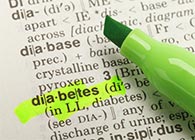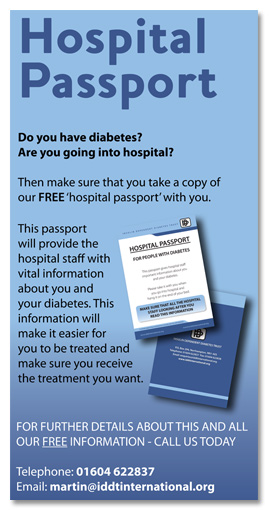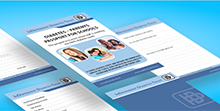Avandia suspended – 23.09.10
The European Medicines Agency has recommended the suspension of the marketing authorisation for Avandia [rosiglitazone] and Avandamet – medicines used to treat Type 2 diabetes. This is as a result of accumulating evidence that Avandia increases the risk of heart disease and stroke to a point where its risks now outweigh its benefits.
These medicines will stop being available in the UK from October 21st 2010 and from this date all stocks will be recalled.
Any adverse side effects experienced by someone taking Avandia or Avandamet should be reported to the Medicines and Healthcare Products Regulatory Agency (MHRA).
People who are currently taking these medicines should make an appointment with their doctor to discuss suitable alternative treatments. You are advised not to stop these medicines without speaking to your doctor.
Doctors should stop prescribing Avandia and Avandia -containing medicines. People who are currently taking Avandia should be reviewed to have their treatment changed.
The suspension will remain in place unless the marketing authorisation holder can provide convincing data to identify a group of patients in whom the benefits of the medicines outweigh their risks. The Committee’s recommendation has now been forwarded to the European Commission for the adoption of a legally binding decision.
The U.S. Food and Drug Administration [FDA] also announced that it will significantly restrict the use of the diabetes drug Avandia (rosiglitazone) to patients with Type 2 diabetes who cannot control their diabetes on other medications.
The FDA will require that the manufacturers, GSK, develop a restricted access program for Avandia under a risk evaluation and mitigation strategy. This will require Avandia to be available to new patients only if they are unable to achieve glucose control on other medications and are unable to take Actos (pioglitazone), the only other drug in this class. Current users of Avandia who are benefiting from the drug will be able to continue using the medication if they choose to do so.
Doctors will have to attest to and document their patients’ eligibility; patients will have to review statements describing the cardiovascular safety concerns associated with this drug and acknowledge they understand the risks. The FDA anticipates that this strategy will significantly limit use of Avandia.
Background to the Safety of Avandia
There has been intense media coverage over the last few weeks of the scandal emerging around Avandia – a drug used to treat Type 2 diabetes, manufactured by drug giant GlaxoSmithKline (GSK).
Studies have shown that Avandia [also called rosiglitazone] causes an increased risk of stroke and heart failure. Manufacturer, GSK, continue to defend the drug despite already paying out millions of dollars in settlements to patients or their relatives in the US. Several more studies, published this year, have again demonstrated that Avandia causes an increased risk of stroke and heart failure.
IDDT has tried to keep Newsletter readers up to date with news about the safety of Avandia but decisions have taken too long and patients have been put at risk.
Avandia has been prescribed for the last ten years but now it has emerged that GSK knew that there were cardiac risks associated with the drug but chose to downplay these risks, before it became public knowledge.
It has been reported that the UK drug regulator, the Medicines and Healthcare Products Regulatory Authority was advised by the Commission on Human Medicines to withdraw Avandia last July because its “risks outweigh its benefits.” However, it remains on the market because the European Medicines Agency, which licenses drugs across Europe, has yet to reach a decision. The situation is similar in the United States.
This news is highly alarming and IDDT has already been contacted by several people taking Avandia, who have been deeply worried and have wanted to change their medication. The advice IDDT is giving is not to stop taking your medication but to go to see your doctor to discuss alternative treatment options. It may also be worth bearing in mind that one option you may be offered is Actos (pioglitazone). This comes from the same family of drugs as Avandia and concerns have also been expressed about the safety of Actos.
European Medicines Agency recommends suspension of Avandia, Avandamet and Avaglim
Anti-diabetes medication to be taken off the market
The European Medicines Agency today recommended the suspension of the marketing authorisations for the rosiglitazone-containing anti-diabetes medicines Avandia, Avandamet and Avaglim. These medicines will stop being available in Europe within the next few months.
Patients who are currently taking these medicines should make an appointment with their doctor to discuss suitable alternative treatments. Patients are advised not to stop their treatment without speaking to their doctor.
Doctors should stop prescribing rosiglitazone-containing medicines. Patients taking rosiglitazone-containing medicines should be reviewed in a timely manner to amend their treatment.
The current review of rosiglitazone by the Agency’s Committee for Medicinal Products for Human Use (CHMP) was initiated on 9 July 2010 following the availability of new studies questioning the cardiovascular safety of the medicine.
Since its first authorisation, rosiglitazone has been recognised to be associated with fluid retention and increased risk of heart failure and its cardiovascular safety has always been kept under close review. Consequently, the use of rosiglitazone was restricted to a second-line treatment and contra-indicated in patients with heart failure or a history of heart failure when it was first granted a marketing authorisation as Avandia in 2000.
Data from clinical trials, observational studies and meta-analyses of existing studies that have become available over the last three years have suggested a possibly increased risk of ischaemic heart disease associated with the use of rosiglitazone. Further restrictions on the use of these medicines in patients with ischaemic heart disease were introduced.
The availability of recent studies has added to the knowledge about rosiglitazone and overall, the accumulated data support an increased cardiovascular risk of rosiglitazone. In view of the restrictions already in place on the use of rosiglitazone, the Committee could not identify additional measures that would reduce the cardiovascular risk. The Committee therefore concluded that the benefits of rosiglitazone no longer outweigh its risks and recommended the suspension of the marketing authorisation of the medicines.
The suspension will remain in place unless the marketing authorisation holder can provide convincing data to identify a group of patients in whom the benefits of the medicines outweigh their risks.
The Committee’s recommendation has now been forwarded to the European Commission for the adoption of a legally binding decision.
PERSPECTIVE
FDA Regulatory Action on Rosiglitazone
September 23, 2010 | J. Woodcock, J.M. Sharfstein, and M. Hamburg | DOI: 10.1056/NEJMp1010788
Because of cardiovascular risk, the FDA is requiring the sponsor of the diabetes drug rosiglitazone to submit a Risk Evaluation and Mitigation Strategy (REMS). Under the REMS, the drug will be available to patients not already taking it only if they are unable to achieve glycemic control using other medications and, in consultation with their health care professional, decide not to take pioglitazone for medical reasons.
For Immediate Release: Sept. 23, 2010
Media Inquiries: Karen Riley, 301-796-4674; [email protected]
Consumer Inquiries: 888-INFO-FDA
FDA significantly restricts access to the diabetes drug Avandia
Makes regulatory decisions on RECORD and TIDE trials
The U.S. Food and Drug Administration today announced that it will significantly restrict the use of the diabetes drug Avandia (rosiglitazone) to patients with Type 2 diabetes who cannot control their diabetes on other medications. These new restrictions are in response to data that suggest an elevated risk of cardiovascular events, such as heart attack and stroke, in patients treated with Avandia.
“The FDA is taking this action today to protect patients, after a careful effort to weigh benefits and risks,” said FDA Commissioner Margaret A. Hamburg, M.D. “We are seeking to strike the right balance to support clinical care.”
Rosiglitazone also is available in combination with other diabetes medications, metformin under the brand name Avandamet or glimepiride under the brand name Avandaryl.
Avandia, manufactured by GlaxoSmithKline (GSK), is in a class of drugs known as thiazolidinediones, or TZDs. It is intended to be used in conjunction with diet and exercise to improve glucose (blood sugar) control in patients with Type 2 diabetes mellitus.
The FDA will require that GSK develop a restricted access program for Avandia under a risk evaluation and mitigation strategy, or REMS. Under the REMS, Avandia will be available to new patients only if they are unable to achieve glucose control on other medications and are unable to take Actos (pioglitazone), the only other drug in this class. Current users of Avandia who are benefiting from the drug will be able to continue using the medication if they choose to do so.
Doctors will have to attest to and document their patients’ eligibility; patients will have to review statements describing the cardiovascular safety concerns associated with this drug and acknowledge they understand the risks. The agency anticipates that the REMS will limit use of Avandia significantly.
“Allowing Avandia to remain on the market, but under restrictions, is an appropriate response, given the significant safety concerns and the scientific uncertainty still remaining about this drug,” said Janet Woodcock, M.D., director of the FDA’s Center for Drug Evaluation and Research.
Also today, the FDA ordered GSK to convene an independent group of scientists to review key aspects of the company’s clinical trial known as RECORD, which studied the cardiovascular safety of Avandia compared to standard diabetes drugs. During the course of the FDA’s review of the RECORD study, important questions arose about potential bias in the identification of cardiovascular events. The FDA is requiring this independent review to provide additional clarity about the findings.
In addition, the agency halted the GSK’s clinical trial known as TIDE and rescinded all of the regulatory deadlines for completion of the trial. The TIDE trial compares Avandia to Actos and to standard diabetes drugs.




































